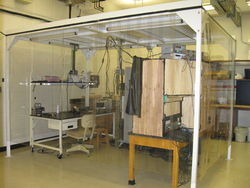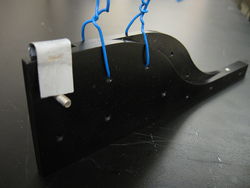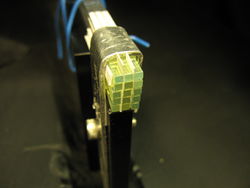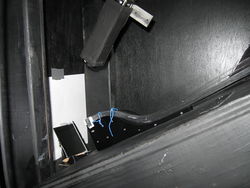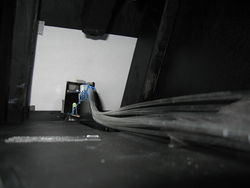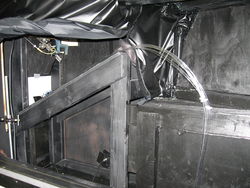Difference between revisions of "Fiber Testing Procedure"
Jump to navigation
Jump to search
| Line 3: | Line 3: | ||
'''If the electronics are powered and the dark box is open, the siliconphotomultipliers WILL be damaged''', so it is very important to make sure electronics are off before the dark box is opened. | '''If the electronics are powered and the dark box is open, the siliconphotomultipliers WILL be damaged''', so it is very important to make sure electronics are off before the dark box is opened. | ||
| − | + | ==Procedure== | |
| + | |||
| + | [[image:LH-FiberTesting-CleanRoom.jpg|250px]] | ||
*Before taking any fibers out of the dark room, open the [https://docs.google.com/spreadsheets/d/11dipDk7WZ5PHp3xFHyUtVzUyJhcY9ewnyDf5FEbtbig/edit| Fiber testing spreadsheet] and click on the tab titled "Fiber Tests 2." In this tab, the fibers to be tested have been put in the appropriate chimney slot column and in the matrix placement of fibers. | *Before taking any fibers out of the dark room, open the [https://docs.google.com/spreadsheets/d/11dipDk7WZ5PHp3xFHyUtVzUyJhcY9ewnyDf5FEbtbig/edit| Fiber testing spreadsheet] and click on the tab titled "Fiber Tests 2." In this tab, the fibers to be tested have been put in the appropriate chimney slot column and in the matrix placement of fibers. | ||
| Line 22: | Line 24: | ||
*Once the fibers are in the order they belong, begin placing them in the clamp on the popsicle stick. | *Once the fibers are in the order they belong, begin placing them in the clamp on the popsicle stick. | ||
**This step will take two people. One person should place the fibers, while the other should hold them in place once they are placed. This way fibers will stay in their appropriate positions. | **This step will take two people. One person should place the fibers, while the other should hold them in place once they are placed. This way fibers will stay in their appropriate positions. | ||
| + | |||
| + | [[image:LH-FiberTesting-PopStickClamp.jpg|250px]] | ||
*Loosen the clamp and move it down over the fibers. Tighten it enough so they do not slip but not too tight as to make it impossible to add paper spacers in the near future. Also use the wires that are going through the holes in the popscile stick to your advantage. Tightening them around the fibers will do a good job of keeping the fibers in place. | *Loosen the clamp and move it down over the fibers. Tighten it enough so they do not slip but not too tight as to make it impossible to add paper spacers in the near future. Also use the wires that are going through the holes in the popscile stick to your advantage. Tightening them around the fibers will do a good job of keeping the fibers in place. | ||
| Line 32: | Line 36: | ||
*Next, put strips of paper between each of the 3 columns. These strips of paper do not need to go far back, just far enough that they will not block any light from the pulser getting to the fiber face. | *Next, put strips of paper between each of the 3 columns. These strips of paper do not need to go far back, just far enough that they will not block any light from the pulser getting to the fiber face. | ||
| + | |||
| + | [[image:LH-FiberTesting-PaperSpacers.jpg|250px]] | ||
*The next step is to put spacers in the middle of the s-bend in the fibers for both columns and rows. | *The next step is to put spacers in the middle of the s-bend in the fibers for both columns and rows. | ||
| Line 39: | Line 45: | ||
*Once each fiber has been pushed into the rigid material, the fibers should be held in place by twisting the wire tightly around them. The rigid material should be carefully moved away to determine if the fibers are flush. If not, repeat the process again. | *Once each fiber has been pushed into the rigid material, the fibers should be held in place by twisting the wire tightly around them. The rigid material should be carefully moved away to determine if the fibers are flush. If not, repeat the process again. | ||
| + | |||
| + | |||
| + | [[image:LH-FiberTesting-Pulsar1.jpg|250px]][[image:LH-FiberTesting-Pulsar2.jpg|250px]][[image:LH-FiberTesting-Pulsar3.jpg|250px]] | ||
| + | |||
| + | [[image:LH-FiberTesting-InsideDarkBox.jpg|250px]] | ||
Revision as of 17:46, 5 June 2014
It is important to determine light yield of each fiber before shipment to Jefferson Lab. In order to do this, light yield tests will be performed on each fiber in our dark box using a red laser diode on a pulsing circuit. The setup of the fibers is very important, as any offset fibers could give an inaccurate result. It is also important that procedure is followed to prevent damage to electronics.
If the electronics are powered and the dark box is open, the siliconphotomultipliers WILL be damaged, so it is very important to make sure electronics are off before the dark box is opened.
Procedure
- Before taking any fibers out of the dark room, open the Fiber testing spreadsheet and click on the tab titled "Fiber Tests 2." In this tab, the fibers to be tested have been put in the appropriate chimney slot column and in the matrix placement of fibers.
- Before selecting fibers from their dark room, don a pair of powder free gloves and place the popsicle stick with the testing clamp at the table you will be working.
- Note which fibers are to be tested during the run and take only those fibers out of the dark room.
- If no meeting is going on in the conference room, bring the fibers in there and turn off all the lights.
- If someone is in the conference room, the clean room is a good alternative.
- Using the matrix in the spreadsheet as a guide, split the fibers in to the appropriate 3 columns of 5 fibers.
- Start with one column and put the fibers from that column in their appropriate order per the matrix on the spreadsheet.
- Continue this process with the remaining two columns.
- Once the fibers are in the order they belong, begin placing them in the clamp on the popsicle stick.
- This step will take two people. One person should place the fibers, while the other should hold them in place once they are placed. This way fibers will stay in their appropriate positions.
- Loosen the clamp and move it down over the fibers. Tighten it enough so they do not slip but not too tight as to make it impossible to add paper spacers in the near future. Also use the wires that are going through the holes in the popscile stick to your advantage. Tightening them around the fibers will do a good job of keeping the fibers in place.
- The fibers do not have to be flush with one another at this point. The next step, putting in paper spacers, will move them out of alignment anyways, so do not waste time on a step that will have to be repeated.
- To add paper spacers, use an index card and cut strips that are the width of the lines on the card. Then cut them into pieces that are about .5 inches long.
- The first set of paper spacers will go on the scintillating fiber end. Place strips of paper between each of the rows, and push them about an inch into the fiber. You will need to use any bit of paper that is sticking out of the sides to do this as you can't push between the rows themselves.
- Also place a strip of paper between the popsicle stick and the bottom row of fibers.
- Next, put strips of paper between each of the 3 columns. These strips of paper do not need to go far back, just far enough that they will not block any light from the pulser getting to the fiber face.
- The next step is to put spacers in the middle of the s-bend in the fibers for both columns and rows.
- Now it is time to make the face of the scintillating fibers flush with one another. This job also takes two people.
- One person should be holding a rigid piece of material along the popsicle stick where the fibers protrude while another person goes through each fiber and one by one pushes it in to the material.
- Once each fiber has been pushed into the rigid material, the fibers should be held in place by twisting the wire tightly around them. The rigid material should be carefully moved away to determine if the fibers are flush. If not, repeat the process again.
